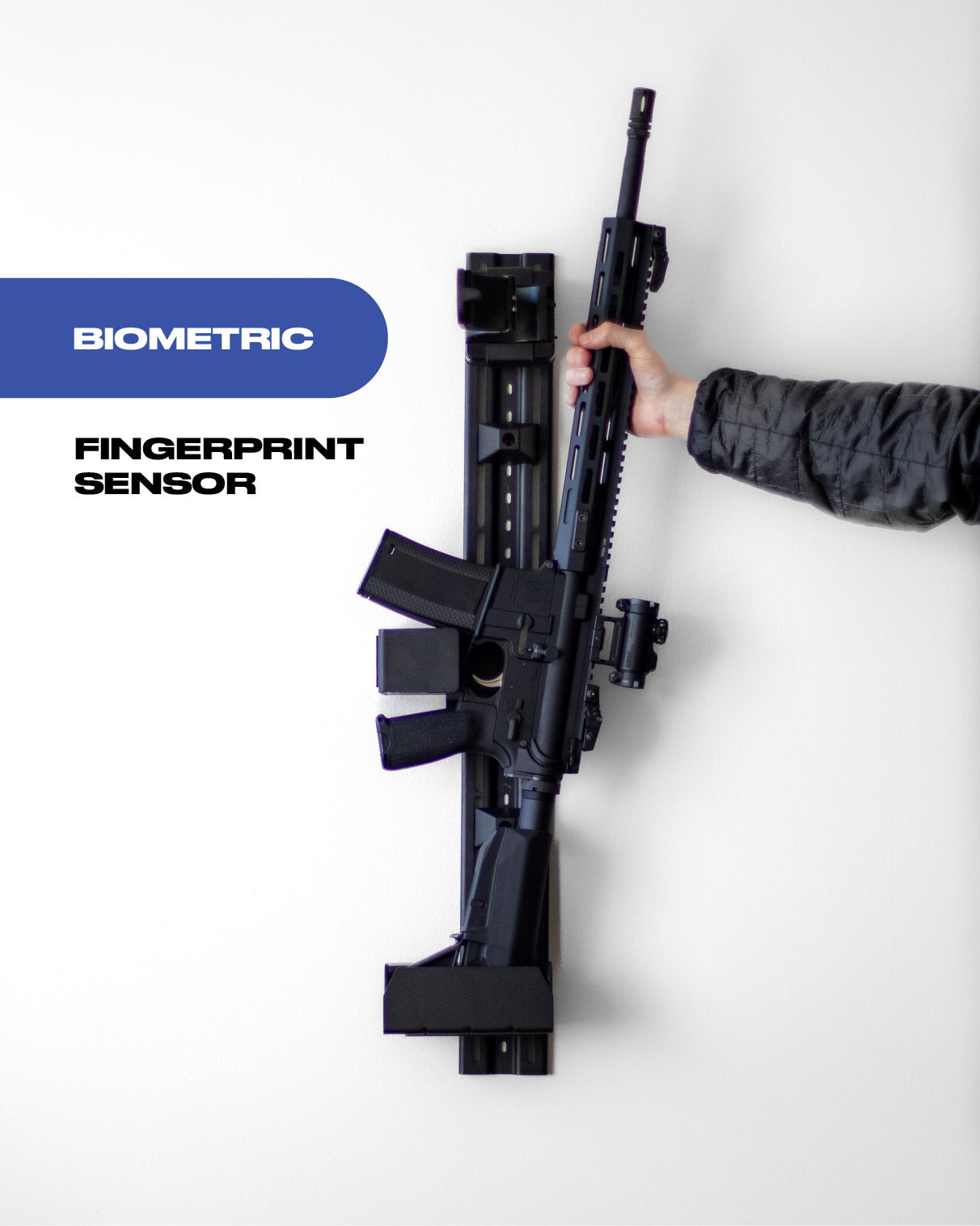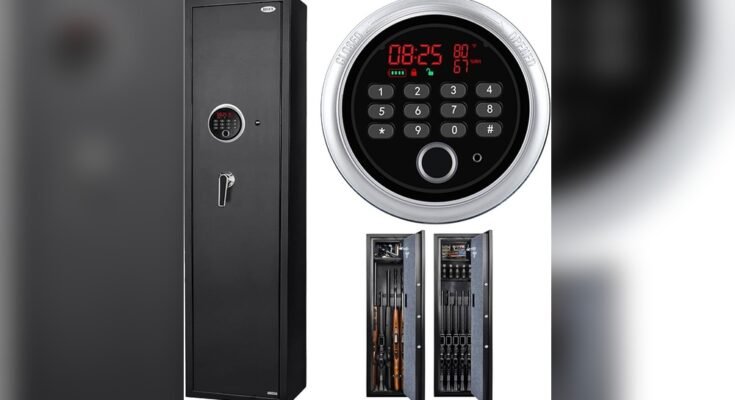When it comes to keeping your firearms secure, every second counts. You want quick access, but without sacrificing safety.
So, how fast is a biometric rifle safe unlock time really? If you’ve ever wondered whether these safes can open swiftly in critical moments, you’re not alone. This article will break down exactly how fast you can expect your biometric rifle safe to unlock, what factors influence that speed, and why it matters for your peace of mind.
Keep reading to discover how technology is changing gun safety—and how it can work for you.

Biometric Rifle Safes Basics
Biometric rifle safes offer quick and secure access to firearms. They use fingerprints or other biological data to verify identity. This technology helps keep rifles safe from unauthorized users. It also allows fast access in emergencies. Understanding how these safes work can help you choose the right one.
These safes combine security with convenience. Unlike traditional locks, biometric safes do not need keys or combinations. This reduces the time it takes to open the safe. The technology is reliable and improves safety for gun owners.
How Biometric Technology Works
Biometric safes scan a unique physical feature to allow access. Most use fingerprints. The safe stores a digital image of authorized fingerprints. When you place your finger on the scanner, it compares the print to the stored images. If they match, the lock opens.
The scanner uses sensors to capture detailed fingerprint patterns. It then analyzes ridges and valleys on the finger. This process happens in seconds. The safe responds quickly to the correct fingerprint and stays locked for others.
Types Of Biometric Sensors
Different sensors detect fingerprints in various ways. Optical sensors use light to take a picture of the fingerprint. They are common but may struggle with dirty or wet fingers.
Capacitive sensors detect electrical signals from the skin. They provide more accuracy and are harder to fool. Ultrasonic sensors use sound waves to map fingerprint details. These sensors work well in tough conditions.
Each type has strengths and weaknesses. Choosing the right sensor affects how fast and reliable the safe opens. High-quality sensors improve both speed and security.

Factors Affecting Unlock Speed
Several factors affect how fast a biometric rifle safe opens. These factors influence the sensor’s ability to read fingerprints and the mechanism’s speed. Understanding them helps set the right expectations for safe access.
Sensor Quality And Response Time
The quality of the fingerprint sensor plays a big role in unlock speed. High-quality sensors capture prints quickly and clearly. They reduce errors and speed up the reading process. Low-quality sensors might struggle with accuracy and slow the safe’s response.
User Fingerprint Registration
How well a fingerprint is registered affects the speed too. Clear and complete fingerprint data helps the sensor recognize the user faster. Poor registration can cause delays or failed attempts. It is best to register multiple prints for better results.
Environmental Influences
External conditions can impact how fast the safe opens. Dirt, moisture, or extreme temperatures may affect sensor performance. Wet or dirty fingers can slow the reading process. Keeping fingers and the sensor clean ensures smoother operation.
Average Unlock Times
Average unlock times for biometric rifle safes vary depending on the model and technology. These times affect how quickly you can access your firearm in urgent situations. Understanding typical speeds helps set realistic expectations.
Typical Speed Range
Most biometric rifle safes open within 1 to 3 seconds. Some top models can respond in under 1 second. Others might take up to 5 seconds, depending on fingerprint scanning speed and processing. Fast response is important for safety and quick access.
Comparison With Traditional Locks
Traditional locks, like keys or combination dials, usually take longer. Keys require finding and inserting, which can take 5 to 10 seconds. Combination dials need time to align numbers, sometimes 10 seconds or more. Biometric safes offer a clear advantage in speed and ease of use.
Top Fastest Biometric Rifle Safes
Biometric rifle safes offer quick access to firearms using fingerprint technology. Speed matters most in emergencies. Fast response times can make a difference in safety and protection.
Choosing the right safe means balancing speed with security. Many brands compete to provide fast and reliable biometric access. Knowing the fastest options helps buyers decide.
Leading Brands And Models
Several brands lead the market in biometric safe speed. GunVault, Vaultek, and Barska are top names. Their models use advanced sensors for rapid fingerprint reading.
GunVault’s SpeedVault series is popular for its quick response. Vaultek’s VT series offers fast access and solid build quality. Barska’s Quick Access models combine speed with ease of use.
Speed Benchmarks
Typical biometric safe unlock times range from 0.3 to 1.5 seconds. The fastest models open in about 0.3 to 0.5 seconds. Most safes average around one second for fingerprint recognition.
Factors affecting speed include sensor quality and fingerprint database size. Smaller fingerprint databases usually result in quicker access. Battery strength also impacts response time.
Regular maintenance keeps the fingerprint sensor working at peak speed. Dirt or moisture on the sensor slows down recognition. Clean your safe sensor often for best performance.
Improving Your Safe’s Unlock Time
Improving your biometric rifle safe’s unlock time boosts security and convenience. A faster response means quick access in urgent moments. Small changes can make a big difference in speed and reliability.
Proper Finger Placement
Place your finger flat and centered on the sensor. Avoid pressing too hard or too lightly. Consistent finger placement helps the sensor read your fingerprint quickly. Practice placing your finger the same way each time.
Regular Sensor Maintenance
Keep the sensor clean and dry for best results. Wipe it gently with a soft cloth to remove dirt and oils. Avoid harsh chemicals that could damage the sensor. Regular cleaning prevents errors and delays in reading fingerprints.
Security Vs. Speed Trade-offs
Biometric rifle safes offer a quick way to access firearms using fingerprint recognition. But faster access often means lowering some security measures. This balance between speed and safety is important to understand. Choosing the right settings affects how well your safe protects your rifle and how fast you can get to it in an emergency.
Balancing Quick Access And Safety
Fast access saves precious seconds during emergencies. Yet, speeding up the process can reduce the safe’s ability to block unauthorized users. Many safes allow you to adjust how sensitive the fingerprint scanner is. Higher sensitivity means quicker recognition but may lead to more false accepts. Lower sensitivity increases security but slows down access. The goal is to find the right balance that fits your needs.
Risks Of Faster Unlock Settings
Setting your safe to unlock very fast can cause security risks. The scanner might open for fingerprints that only partially match. This can let strangers get inside your safe. Also, faster settings might cause more false positives from dirty or wet fingers. This reduces the safe’s reliability. Slower settings reduce these risks but add seconds to access time. Consider how much speed you need and what risks you can accept.
Real-world User Experiences
Real-world user experiences reveal how biometric rifle safes perform outside labs. These safes promise quick access, but actual times vary. Users share insights on everyday use, giving a clear picture of what to expect. The feedback covers speed, reliability, and common issues faced by owners. Understanding these helps choose the right safe for personal needs.
Feedback From Gun Owners
Many gun owners report fast access times, often under five seconds. Fingerprint recognition usually works well after initial setup. Some users say the safe opens instantly with a clean finger scan. Others note slight delays if fingers are wet or dirty. Overall, most find biometric safes faster than traditional locks. Quick access adds peace of mind during emergencies.
Common Unlock Challenges
Some users experience trouble with fingerprint sensors in cold or dry conditions. Sensors may fail to read if fingers are cut or scarred. Battery life also affects performance; low power can slow response. In rare cases, multiple attempts are needed to open the safe. Dirt and grime on sensors cause delays too. Regular cleaning and maintenance improve reliability.

Frequently Asked Questions
How Fast Do Biometric Rifle Safes Unlock?
Biometric rifle safes typically unlock within 1 to 3 seconds. This quick access is crucial for emergencies and ensures your firearm is ready when needed.
What Affects Biometric Safe Unlock Speed?
Unlock speed depends on fingerprint sensor quality, battery life, and user setup. High-quality sensors and fresh batteries provide faster, more reliable access.
Are Biometric Rifle Safes Faster Than Traditional Locks?
Yes, biometric safes usually unlock faster than combination or key locks. They offer instant access with fingerprint recognition, eliminating the need for codes or keys.
Can Multiple Fingerprints Be Registered For Quick Access?
Most biometric safes allow multiple fingerprint registrations. This feature enables trusted users to access the safe quickly without delay.
Conclusion
Biometric rifle safes open quickly, usually within seconds. This speed helps in urgent moments. Accuracy matters too; a good sensor recognizes your fingerprint fast. Some models may take a little longer, but most stay under 5 seconds. Choosing the right safe means balancing speed and security.
Fast access can make a big difference for safety. Always check reviews and specs before buying. A reliable biometric safe provides peace of mind. Quick, easy, and secure – that’s what you want.
